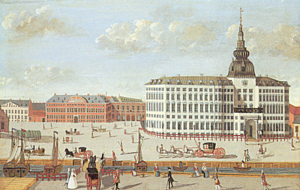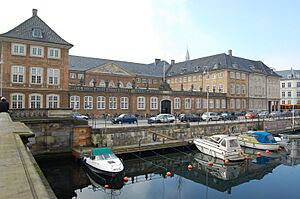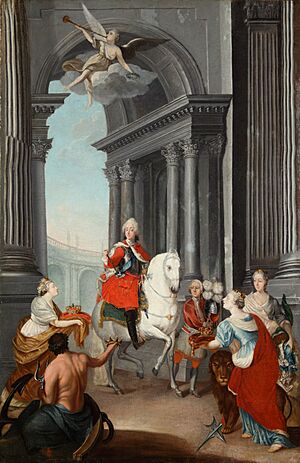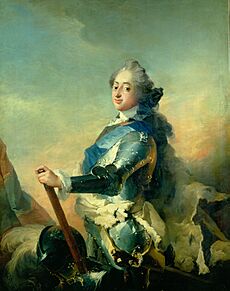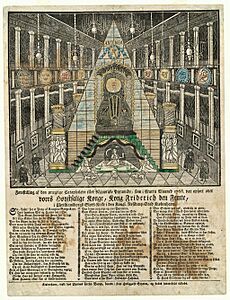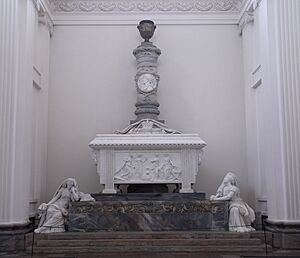Frederick V of Denmark facts for kids
Quick facts for kids Frederick V |
|
|---|---|

Portrait by Carl Gustaf Pilo, c. 1748–51
|
|
| King of Denmark and Norway (more...) | |
| Reign | 6 August 1746 – 14 January 1766 |
| Coronation | 4 September 1747 Frederiksborg Palace Chapel |
| Predecessor | Christian VI |
| Successor | Christian VII |
| Chief Ministers |
See list
Johan Ludvig Holstein
Count Johann Hartwig Ernst von Bernstorff |
| Born | 31 March 1723 Copenhagen Castle, Copenhagen, Denmark |
| Died | 14 January 1766 (aged 42) Christiansborg Palace, Copenhagen, Denmark |
| Burial | Roskilde Cathedral |
| Spouse |
|
| Issue |
|
| House | Oldenburg |
| Father | Christian VI of Denmark |
| Mother | Sophie Magdalene of Brandenburg-Kulmbach |
| Religion | Lutheran |
| Signature |  |
Frederick V (in Danish and Norwegian: Frederik V; born March 31, 1723 – died January 14, 1766) was the King of Denmark and Norway. He was also the Duke of Schleswig-Holstein from August 6, 1746, until his death in 1766. He was a member of the House of Oldenburg. Frederick was the son of Christian VI of Denmark and Sophie Magdalene of Brandenburg-Kulmbach.
Even though Frederick's personal power was limited, his time as king saw great growth in business and trade. Art and science also did very well. Unlike his parents, who were very religious, Frederick enjoyed life's pleasures. As king, he attended government meetings. However, most of his rule was guided by smart ministers. These ministers were inspired by the ideas of the Age of Enlightenment. They helped trade and new industries grow. They also kept Denmark-Norway out of the wars happening in Europe at that time. Frederick V wasn't very interested in culture himself, but his first wife was. Public entertainment and freedom of expression, which had been stopped by his father, were allowed again.
Contents
Early Life of Frederick V
Birth and Family
Prince Frederick was born on March 31, 1723. He was the grandson of King Frederick IV of Denmark and Norway. He was the only son of Crown Prince Christian and Sophie Magdalene of Brandenburg-Kulmbach. Frederick was the last Danish prince born in the old Copenhagen Castle. This castle was very old and started to fall apart.
In 1731, the castle was torn down. A new, grander palace, the Baroque style Christiansborg Palace, was built in its place. Frederick would later rule from this new palace. The young prince was baptized the next day. He was named after his grandfather, King Frederick IV.
As the only son of the Crown Prince, Frederick was expected to become king. His younger sister died when she was a baby in 1724. His only other sister, Princess Louise, was born in 1726. On October 12, 1730, King Frederick IV died. Frederick's father became King Christian VI. Frederick himself became Crown Prince at the age of seven.
Growing Up and Education

King Christian VI and Queen Sophie Magdalene were very religious. They followed a movement called Pietism. This movement focused on personal faith and living a strong Christian life. Because of this, Frederick had a very strict religious upbringing. When he was 7, he got his own royal household. A German nobleman named Georg Wilhelm von Söhlenthal became his hofmeister (tutor). Söhlenthal was very religious, but he was too gentle to guide the Crown Prince. He was removed from his job in 1738.
Frederick's education was not very strong in academics. In 1730, the king put Iver Rosenkrantz in charge of Frederick's upbringing. But this did not help the actual teaching much. Frederick's education was done in the German Pietist style of the court. Like his family before him, he spoke German better than Danish. He had poor Danish skills his whole life. Still, his mother sometimes called him "The Danish Prince" because he spoke Danish now and then. Besides collecting coins, he did not have many other cultural or intellectual interests.
From a young age, Prince Frederick was very different from his serious parents. He was kind, cheerful, and friendly to everyone. He wanted to see his people happy. His parents stayed mostly inside their palaces. But Frederick enjoyed being out in public with all kinds of people. Even though he grew up in a very religious home, he was not very religious himself. He enjoyed the fun parts of life.
A very important person for Frederick's future was Adam Gottlob Moltke. In 1730, Moltke became Frederick's chamber page. Moltke was a nobleman from Mecklenburg and was eleven years older than Frederick. The King and Queen hoped Moltke would help the Crown Prince control himself. In 1743, Moltke became Frederick's Hofmeister. A strong bond of trust grew between them. This bond would be very important when Frederick became king.
In 1740, the Crown Prince was confirmed. As the heir, he was given a seat in the Council of State. In 1743, there was a crisis in Sweden about who would be the next king. Crown Prince Frederick had a good chance of being chosen. The farmers in Sweden even started a rebellion to make him king. However, due to a treaty with Russia, Adolf Frederick of Holstein-Gottorp became the heir instead.
First Marriage
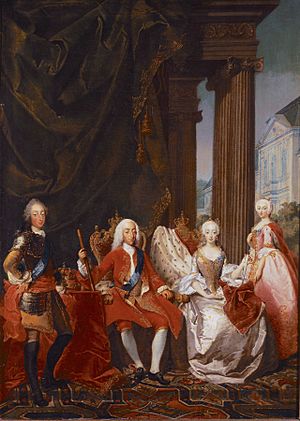
Frederick's parents wanted him to marry quickly. They hoped marriage would help him settle down. In 1743, a marriage was arranged between Frederick and Princess Louise of Great Britain. She was the youngest daughter of King George II. Great Britain suggested this marriage for political reasons. Both France and Great Britain wanted an alliance with Denmark-Norway. Great Britain, being Protestant, had an advantage for a marriage alliance.
The Danish government liked the idea. Frederick's father, King Christian VI, was not sure at first. But he was convinced, hoping the marriage would bring British support for Frederick's claim to the Swedish throne. Frederick saw a portrait of Louise and found her appealing. He also heard she was friendly. He agreed to the marriage, knowing it was good for political reasons.
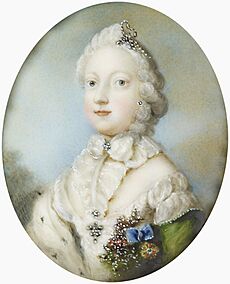
The marriage talks began in 1743 and finished in a few months. They had a proxy wedding (a wedding where someone stands in for the groom) on November 10, 1743, in Hanover. Louise's brother, the Duke of Cumberland, stood in for Frederick. A week later, Louise and Frederick met for the first time in Altona. They then traveled to Copenhagen. Louise entered the city on December 11, 1743, to big cheers from the people. On the same day, a second wedding ceremony was held at the chapel of the new Christiansborg Palace.
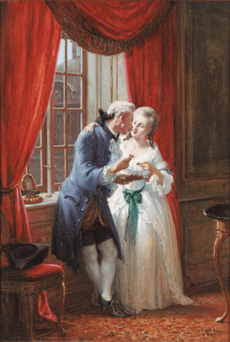
Louise quickly became popular with the royal court and the public. This was because of her natural and friendly way of acting. Her popularity also made her husband more liked. Even though their marriage was arranged, they got along well. Their relationship was friendly, especially in the early years. They had five children. Their oldest son, Crown Prince Christian, died as a baby.
After the wedding, the couple first lived at Charlottenborg Palace. This was a Baroque style royal home in Copenhagen. In 1745, they moved into the finished Prince's Mansion. This city home was remodeled for them by Nicolai Eigtved in the new Rococo style. Their home quickly became a lively and fun court. It was very different from the strict court of his parents at Christiansborg Palace.
Frederick V's Reign
Becoming King
On August 6, 1746, Frederick's father died at Hirschholm Palace. Frederick immediately became King of Denmark and Norway. He was just 23 years old. The new king and queen moved from the Prince's Mansion to the large Christiansborg Palace. On September 4, 1747, they were anointed (a special ceremony) in Frederiksborg Palace's Chapel. This was the traditional place for coronations in Denmark-Norway.
Frederick V becoming king brought big changes to the Danish court. It became much more festive and relaxed than under his very religious parents. Frederick and Louise had started this relaxed style at their earlier homes. Now they continued it on a grand scale at Christiansborg. His parents had kept themselves away from people. But Frederick V seemed to want to meet the people. It is said that he and the queen enjoyed spending time with Copenhagen citizens and visiting farmers. As a sign of the new times, the heavy iron chains around Christiansborg, which kept people away, were removed. Court life became grand again. The palace halls were filled with balls and social events. Ordinary people were now invited to court events. The writer Ludvig Holberg described how comfortable he felt at Frederick V's court.
How Frederick V Ruled

Frederick's personal influence as king was limited. He appointed A. G. Moltke, his close friend, as his Lord Chamberlain. This job became very important. Moltke was always with the king and could influence him in many ways. Frederick's main interest was the art of war. He also enjoyed hunting.
Even though the king attended government meetings, skilled ministers mostly ran the country. These included A. G. Moltke, J. H. E. Bernstorff, and H. C. Schimmelmann. They helped trade and new industries grow, like the gunpowder and cannon factory in Frederiksværk. They also kept Denmark-Norway out of the European wars of the time. The country stayed neutral during the Seven Years' War (1756–1763). This was important because Russia and Sweden were fighting nearby. This neutrality helped make the period a happy time.
During this time, the Royal Frederiks Hospital and the Royal Orphanage were created. The orphanage was a school for poor boys. It opened in Christianshavn on October 1, 1753, and still exists today. On June 29, 1753, Frederick V started Denmark's first lottery. It was called the Royal Copenhagen Lottery and is still around today.
Art and science did well under his rule. Frederick himself was not very interested in culture. However, public entertainment, performing arts, and freedom of expression were allowed again. These had been banned under his religious father. His first wife encouraged performances by actors and musicians. In 1748, the Royal Danish Theatre opened in Copenhagen. In 1754, the Royal Danish Academy of Art was founded in Copenhagen. It was officially opened on March 31, 1754, Frederick's 31st birthday. Frederick bought what became known as the Danish West Indies from the Danish West India Company in 1754.
Second Marriage
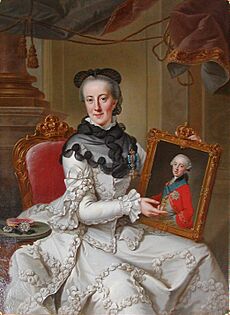
Queen Louise died suddenly on December 19, 1751, at Christiansborg Palace. Her death greatly affected the royal family and the court. She was very much loved. She was buried at Roskilde Cathedral. When she died, she was pregnant with her sixth child, who also died.
The government thought it was best for the king to remarry soon. They hoped it would help him settle down. The king did not want to marry another foreign princess unless she was English. But no English princesses were available. Moltke then suggested Duchess Juliana Maria of Brunswick-Wolfenbüttel. She was the sister-in-law of Frederick the Great of Prussia. The king agreed to marry her. The wedding took place at Frederiksborg Castle on July 8, 1752. The people did not like this marriage. They thought it was too soon for the king to remarry. Juliana Maria was not popular at court. This was perhaps because her strict manners seemed less friendly than Louise's.
Their only child, Hereditary Prince Frederick, was born in 1753. He later became the father of King Christian VIII of Denmark. Juliana Marie died in 1796. She had been a regent for her son Prince Frederick.
Death and Burial
Over the years, the king's way of life affected his health. He became sadder and neglected himself and state matters. He broke his leg twice in accidents. These long recoveries weakened him a lot. It is said that the king was often in a state where he needed Moltke's help to put his hat back on. He became very weak. On January 14, 1766, the king died at Christiansborg Palace. He was 42 years old and had ruled for 20 years. He had been a pleasant change from his very religious father. Many people mourned when Frederick died. His last words were reportedly: "It is a great comfort to me in my last hour that I have never willingly offended anyone, and that there is not a drop of blood on my hands."
After a grand ceremony at the chapel in Copenhagen, he was buried next to Queen Louise in Roskilde Cathedral. This is the traditional burial place for Danish monarchs. His monument in Roskilde Cathedral was finished in 1769. It was designed by the Danish sculptor Johannes Wiedewelt. It has a large sarcophagus (stone coffin) with many sculptures. Behind it is a column with an urn and a medallion of the king. On each side of the sarcophagus are two crowned, sad female figures. They represent Denmark and Norway.
Legacy
Monuments
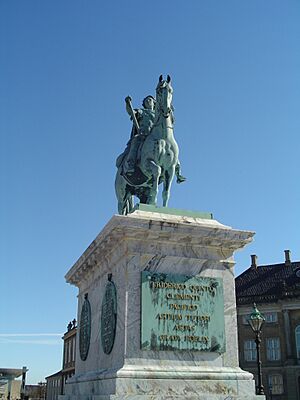
On August 1, 1771, five years after the king's death, a statue of Frederick V was unveiled. It was an equestrian statue (a statue of a person on a horse). The French sculptor Jacques François Joseph Saly made it. The statue shows Frederick V dressed like a Roman emperor. It is located in Amalienborg Square in Copenhagen.
Places Named After Frederick V
- The town of Frederiksværk in Denmark.
- The town of Frederiksted on St. Croix in the U.S. Virgin Islands.
- The district Frederiksstaden in central Copenhagen, Denmark.
- The city of Serampore in India was called Frederiksnagore from 1755 to 1845.
- The city of Paamiut in Greenland was formerly known as Frederikshaab.
- The former naval base Fredriksvern in Norway.
Issue
| Name | Birth | Death | Notes |
|---|---|---|---|
| Crown Prince Christian | Copenhagen, 7 July 1745 | Frederiksborg, 3 June 1747 | died in infancy |
| Princess Sophia Magdalena | 3 July 1746 | 21 August 1813 | married, 1766, Gustav III, King of Sweden; had issue |
| Princess Wilhelmina Caroline | 10 July 1747 | 19 January 1820 | married, 1763, William I, Elector of Hesse; had issue |
| King Christian VII | 29 January 1749 | 13 March 1808 | married, 1766, Princess Caroline Matilda; had issue |
| Princess Louise | 30 January 1750 | 12 January 1831 | married, 1766, Prince Charles of Hesse-Kassel; had issue |
| Hereditary Prince Frederick | 11 October 1753 | 7 December 1805 | married, 1774, Duchess Sophia Frederica of Mecklenburg-Schwerin; had issue |
See also
 In Spanish: Federico V de Dinamarca para niños
In Spanish: Federico V de Dinamarca para niños


